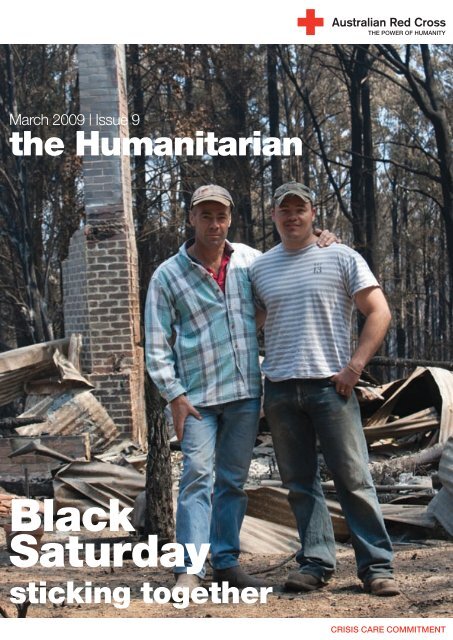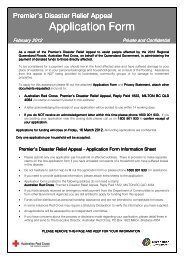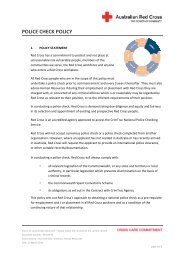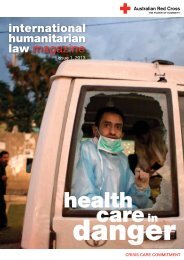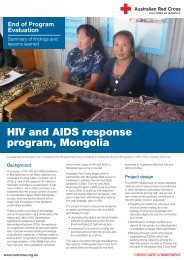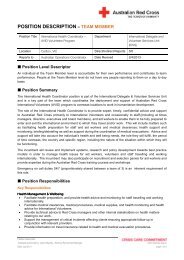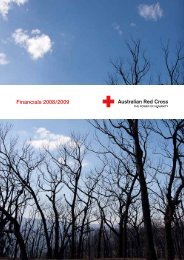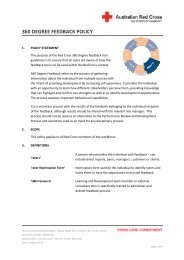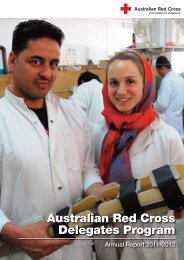Black Saturday - Australian Red Cross
Black Saturday - Australian Red Cross
Black Saturday - Australian Red Cross
- No tags were found...
Create successful ePaper yourself
Turn your PDF publications into a flip-book with our unique Google optimized e-Paper software.
March 2009 | Issue 9the Humanitarian<strong>Black</strong><strong>Saturday</strong>sticking together
P2 the Humanitarianthe insideeditorialBy now, the world over has heard of the devastating fires that have consumedmuch of Victoria. Our hearts are with those who have lost loved ones andwho have been affected by Australia’s worst natural disaster in more thana century.What is truly amazing and exemplifies the ‘power of humanity’ is the waythe community at large has reached out to Victorians in their darkest hour.This includes the international community. Over 500,000 people have madedonations and corporate Australia as well as governments have dug deep,raising over $220 million and counting.Let us not forget the numerous volunteers who have worked around the clockto help those affected by the bushfires.In this edition of the Humanitarian, we have devoted an additional section tothe bushfires.Contributing writer, Damien Kingsbury of Deakin University discusses the factorsthat come into play when trying to reduce the impact of natural disasters.We also look at the recent floods in Queensland and the Brisbane storms ofNovember, where hundreds of people lost their homes to water damage.Further afield in the gold mining town of Kalgoorlie, WA, a holistic programis helping Indigenous locals learn about nutritious food.And in Banda Aceh, Indonesia, the devastation of the 2004 tsunami hassparked some innovative businesses that are proving fruitful.And finally, there is still an urgent need to raise funds to support our day-todaywork in preparing communities for disasters, like the Victorian bushfires,making daily phone calls to elderly people living alone, providing breakfast forkids who would otherwise go without and bringing clean water and health tovillages in the Asia Pacific.Our general donations, like those made by regular givers, donors and corporatepartners meant we were in a position to respond quickly to the Victorianbushfire and to continue to support vulnerable people in all these ways.10whendisasterstrikes24creatingconnections4<strong>Black</strong><strong>Saturday</strong>16coming closerto good healthMake a donation1800 811 700First Aid enquiries1300 367 428Give blood13 14 95Robert TicknerCEO <strong>Australian</strong><strong>Red</strong> <strong>Cross</strong>Michael RaperDirector of Services andInternational Operations<strong>Australian</strong> <strong>Red</strong> <strong>Cross</strong>Front cover: Mick Osborne (left) and Rob Deebletried to save their friends’ home in Kinglake, butlike many the fight proved fruitless as 80km windsroared through the area.
March 2009 P3raging firesdevastate VictoriaPhoto: Courtesy of Bendigo AdvertiserIn what has been labelled Australia’sworst natural disaster in more than acentury, the Victorian bushfires have sofar claimed the lives of 210 people andsome 2,000 homes.Since late January, fires have ragedacross Victoria, causing widespreaddamage. Over 500,000 hectares of landhave been destroyed, with some 4,000firefighters helping to extinguish andcontain the fires.More than 1,000 <strong>Red</strong> <strong>Cross</strong> peopleworked in relief and recovery centres,registering the names of people whowere safe so that worried families andfriends would know that they were ok.Others provided support and comfort,and ensured people had a bed andplenty to eat.At the same time, <strong>Red</strong> <strong>Cross</strong> establishedthe National Inquiry Centre in Melbourne,where volunteers from all over thecountry responded to more than 21,000enquiries from people concernedabout family or friends. In the pastthree weeks, 20,000 people from areasaffected by fires have registeredwith <strong>Red</strong> <strong>Cross</strong>.The community spirit that emergedin response to the bushfires wasoverwhelming. More than $210 millionhas been donated to an appeal fundestablished by the State and FederalGovernments in partnership with<strong>Red</strong> <strong>Cross</strong>.This spirit of generosity has spreadaround the globe, with many <strong>Red</strong> <strong>Cross</strong>and <strong>Red</strong> Crescent national societieslaunching their own appeals or lendingsupport in other ways to people affectedby the fires. This is the first time othernational societies have run appeals foran <strong>Australian</strong> crisis and we are gratefulfor this show of international support.An Independent Advisory Panelheaded by former Victorian GovernorJohn Landy has been established toset criteria for the distribution of theVictorian Bushfire Appeal funds. TheVictorian Government is distributingthe funds through the Department ofHuman Services.Community spiritAfter bushfires tore through the smalltowns of Boolara and Mirboo Northin Gippsland, local people bandedtogether to fight for their homes andmemories. <strong>Red</strong> <strong>Cross</strong> was there,providing personal support andregistration at relief centres as wellas meals for affected residents andemergency services personnel.Boolara resident Liz Tyler lives on astreet destroyed by fire. While many ofher neighbours lost their homes, shesaid that the crisis had brought thecommunity together.‘People have been talking to oneanother because they’ve needed towork together to fight the fires andprotect their houses,’ Ms Tyler said.‘Our neighbours came across and putout the fire that was only a metre fromour window. The three fellows at the topof the hill lost their house but they camedown as well. They saved our home,’she said.
P4 the Humanitarian
March 2009 P5<strong>Black</strong> <strong>Saturday</strong>From the left to right: After escaping the fires and losing his home in Kinglake, Albin Weitacher received help from first-aider Mohammed Alam. - A familiarsite on the road leading out of Kinglake, where many people crashed their vehicles while attempting to escape the ferocious fires. - The remains of a house inKinglake. - Children seeking refuge at relief and recovery centres are entertained by <strong>Red</strong> <strong>Cross</strong> volunteers to pass the time. - Michael O’Meara is supported byhis friend Vicki Ruhr at the Whittlesea relief and recovery centre. Michael lost many close friends in the bushfires. - A firefighter from the CFA takes a muchneededbreak in Kinglake. Photos: <strong>Australian</strong> <strong>Red</strong> <strong>Cross</strong>/Rodney Dekker
P6 the HumanitarianstickingtogetherJules the dog is happy to be reunited with her owner Jae Lovelace after she escaped the horrific fires in Strathewen with the McKenzie family.Photo: <strong>Australian</strong> <strong>Red</strong> <strong>Cross</strong>/Rodney Dekker
March 2009 P7The tiny township of Strathewen is allbut gone except for the chimneys ofsome of the 40 homes and theeucalyptus trees that stand defiant overthe blackened landscape. There were200 people living in the communitynestled on the fringe of Kinglake andnow over 40 are dead.Here is the story of how one family, a fewfriends and three dogs managed toescape the inferno.On 7 February, the hottest day on recordfor Victoria, the biggest concern for theMcKenzie family was how to keep cool.Brothers Dylan (21) and Leigh (22) invitedsome friends around for a swim in theirpool and were happily having a fewdrinks and laughs when the first of thefire embers started spitting on them inthe pool.‘We weren’t too worried then. We’ve beenevacuated before, but usually you get atwo-hour warning. We had been told thatWhittlesea was under threat, but thenflames started coming over the hill, thenspot fires started on our neighbourspaddock. It crept up on us so quickly, therewas no warning...that’s when we realisedwe were in trouble,’ recounts Leigh.‘We could hear the fire roaring and itsounded like a jet plane. It was likenothing I’ve heard before.’It was then that the McKenzie’s and theirfriends began to panic. ‘When the powerwent out, we just went in the housegrabbed a handful of what we could andthen left in five cars. In total, fiveMcKenzies and seven of their friends,plus three dogs piled into the cars.On the way, they ran into their neighbourswho had inconveniently run out of petrol,so they too crammed into the cars asDylan (left) and his brother Leigh McKenzie lost their family home inStrathewen, but their entire family survived along with three dogs,including their friend’s dog Jules. Photo: <strong>Australian</strong> <strong>Red</strong> <strong>Cross</strong>/Rodney Dekkerthey made an attempted escape out ofStrathewen.When they got to Kinglake, however,everything was blocked off, so they hadno choice but to take refuge in abuilding. They ran into the café on themain road that was just across the roadfrom the hardware store and the petrolstation. There were 20 people in the caféincluding the McKenzie clan.‘Shortly after we got to the café, thehardware store caught on fire and then thepetrol station went up. Everything wentblack and it turned to night. There werered embers everywhere. Everyone startedcrying. I thought I was dead,’ recalls Dylan.But somehow, they managed to survivethe night lying low, with wet towels on theirfaces. The windows were too hot to touchor even stand near from a foot away.When the McKenzie’s and their friends leftthe café in the morning, the petrol stationwas still burning (and continued to burnfor 24 hours) and every house waslevelled from Kinglake to Whittlesea. Theyarrived at the recovery centre in Whittleseaand experienced a sense of relief, if onlytemporarily. ‘From coming from nothing tosome food, socks and jocks was a greatthing. We registered with <strong>Red</strong> <strong>Cross</strong> andthen got a bite to eat. It’s what you want isto find some friendly people who want tohelp out,’ explains Dylan.For Jules, one of the dogs who wasrescued, her greatest relief was beingreunited with her owner Jae Lovelace,a friend of the brothers. The smileon the dog’s face is a welcome sightand momentarily helps one to forgetthe tragedy that everyone has justexperienced.by Janine GrayPsychologicalsupport- the next step to recoveryAs recovery efforts get underway inthe areas hardest hit by the bushfires,there is a strong need to be aware ofthe longer-term psychological and socialimpacts, says Dr Rob Gordon, consultantpsychologist to <strong>Red</strong> <strong>Cross</strong>.‘Emergencies by their very nature aredisruptive and can be extremelystressful. And situations like theVictorian bushfires, which have hadsuch an enormous impact, willcertainly have an effect on a largeportion of the population,’ he says.There are a range of emotions thatpeople may be feeling after a majorcrisis, including shock and disbelief,numbness, fear, helplessness and angeror frustration. Many of these feelings willnot be present immediately, and indeedsome may take months or even years tobe fully experienced.‘People should also remember to lookafter their physical state,’ says Dr Gordon.‘The health of the body as well as themind can be directly affected by theevent, with difficulty sleeping, musculartension, weight gain or loss and inabilityto concentrate are all common physicalreactions.’<strong>Red</strong> <strong>Cross</strong> has a number of resources toassist people affected by emergencies,including a booklet on how to cope witha major personal crisis, and podcastsdiscussing how to deal with the stress ofan emergency and how to help out afterone has occurred.If you would like assistanceplease visit www.redcross.org.auand follow the links toEmergency REDiPlan.
P8 the Humanitariannews in brief<strong>Red</strong> <strong>Cross</strong> Calling 2009 not going ahead<strong>Red</strong> <strong>Cross</strong> is currently responding to one of the worst disasters Australia has everseen: the Victorian bushfires.Over the coming weeks and months the operational response to the BushfireAppeal will place unprecedented demands on <strong>Red</strong> <strong>Cross</strong> people and resources,requiring our full focus.Because of this and because we do not want to cause confusion with anotherfundraiser, the decision has been made not to proceed with our major fundraisingcampaign, <strong>Red</strong> <strong>Cross</strong> Calling, this March. We apologise for this change of plans.To find out how you can still help, please visit www.redcross.org.auHeart of the StreetsHip-hop music featuring young homeless people from Brisbane’s <strong>Red</strong> <strong>Cross</strong> NightCafé has just been released on a CD entitled Heart of the Streets.Twenty young people from the <strong>Red</strong> <strong>Cross</strong> Night Café have worked with musicproducer Luke O’Sullivan to record their own hip-hop tracks about mental health,drugs and alcohol, and life on the streets.The CD showcases the musical talents of young people speaking out about thechallenging issues that affect the homeless community. They have created positivemessages and provide advice to others who may be battling with homelessness,drug addiction or mental health problems.‘The background rhythms were created by Luke Sullivan and the performers cameup with their own lyrics based on life experience,’ says <strong>Red</strong> <strong>Cross</strong>’ Jeff Buckley.Hip Hop performer ‘T.C.’ at the launchof Heart of the Streets CD in Brisbane.Photo: Bruce Wardley‘The success of the project is best measuredby the young people themselves, some ofwhom have since made big steps towardsemployment and accommodation.’One of the young performers on the CD hasnow become a full-time musician, writingand performing his own style of rap music.The hip-hop CD project was made possibleusing funds received from The JB Seed,a grants program set up by well-known artistJohn Butler.The <strong>Red</strong> <strong>Cross</strong> Night Café is an after-hourssafe space for ‘at-risk’ young people aged 12to 25. It operates on Tuesday and Thursdaynights as well as on Sunday afternoons.The cafe provides meals and a couple ofhours’ respite from the challenges of living onthe streets. It also provides a space thatgives young people the tools to help themturn their lives around.Permanent homes ‘last step’in tsunami recoveryJust over four years since the tsunamistuck, more than 1,400 houses havebeen built for survivors in Indonesia,with a further 200 under construction.<strong>Australian</strong> <strong>Red</strong> <strong>Cross</strong> has trained 150community health volunteers, distributed250 hygiene kits and built 600 toilets onSimeulue Island. In addition, 190 peoplehave received small business training and10,000 mangrove trees have been plantedto help protect coastlines from erosion aswell as re-establish marine habitats.In Sri Lanka, more than 1,200 houseshave been built or are under constructionand major water and sanitation projectshave been completed. Conflict in thenorth has affected some of our projects,but even in trying circumstances wehave helped families to rebuild the localeconomy.In the Maldives 74 islands have beencleaned up with the removal of 37,000tonnes of household and tsunami debris.Water supplies have been boosted on 44islands by installing 15 desalination units.<strong>Australian</strong> <strong>Red</strong> <strong>Cross</strong> has also contributedto the construction of Dhuvaafaru Island,a community of 3,500 people whoseoriginal islands were made uninhabitable.Collectively, the <strong>Red</strong> <strong>Cross</strong> <strong>Red</strong> Crescentmovement has built more than 41,000permanent houses across the tsunamiaffectedareas, with a further 12,000under construction. <strong>Red</strong> <strong>Cross</strong> hasprovided more than 500,000 people withimproved access to fresh water, and over370,000 people have been treated bycommunity-based first-aid services.More than 101 houses were built by<strong>Australian</strong> <strong>Red</strong> <strong>Cross</strong> for people affectedby the tsunami in Ladong, on the outskirtsof Banda Aceh. The houses are built tothe highest quality standards and areearthquake resistant.
March 2009 P9news in briefHumanitarian crisis in Zimbabwe worsensA Zimbabwean girl carries a bucket of water froma stream in Budiriro neighbourhood in Harare.Photo: REUTERS/Philimon BulawayoZimbabweans are suffering afood crisis and the worst choleraepidemic in their history, withseven million people in need offood aid, according to the WorldFood Programme.Fuelled by the country’s economicdifficulties and a seriousdeterioration in the food supplysituation, the worst choleraepidemic in history has now killedmore than 3,200 people, infectingmore than 64,000 and spreadingto all provinces. There could beworse to come if the continuingrainy season leads to flooding inlow-lying areas.In addition, Zimbabwe is sufferingappallingly as a result of HIV andAIDS. The pandemic claims anestimated 2,300 lives every day.Zimbabwe <strong>Red</strong> <strong>Cross</strong> issupporting some of the country’smost vulnerable people, and isworking closely with the global<strong>Red</strong> <strong>Cross</strong> Movement to provideimmediate food aid, improveaccess to safe and adequatewater and sanitation, and improveawareness on the spread of disease.Longer-term agricultural programs arealso underway to provide people witha way of rebuilding livelihoods andproducing their own food.<strong>Red</strong> <strong>Cross</strong> is monitoring and respondingto the cholera epidemic and helpingto strengthen Zimbabwe <strong>Red</strong> <strong>Cross</strong>.Specialist emergency response unitsare positioned around the country totackle basic health needs and waterand sanitation issues arising from thecholera epidemic.<strong>Australian</strong> <strong>Red</strong> <strong>Cross</strong> launched theZimbabwe Crisis Appeal 2009 to lenda hand.What can you do?Donations to the Zimbabwe CrisisAppeal 2009 will be used by <strong>Red</strong><strong>Cross</strong> to provide emergency food andagricultural recovery items, access toclean water, hygiene and sanitationeducation for up to 1.5 million people,and to send specialist aid workers toassist the <strong>Red</strong> <strong>Cross</strong> response.For more on the appeal visitwww.redcross.org.au and clickon links to how you can helpHenry Baldwin’s generous gift to TasmaniaHenry Baldwin, an engineer and philanthropist, has left a substantial gift to <strong>Red</strong> <strong>Cross</strong> in hiswill – the largest bequest ever received in Tasmania.A long-time volunteer with <strong>Red</strong> <strong>Cross</strong> and passionate humanitarian, Henry’s generosity will help makedaily phone calls to elderly people living alone, provide a healthy breakfast to kids who would otherwisego without and reunite families separated by conflict and disaster.Henry was well known to staff in <strong>Red</strong> <strong>Cross</strong> in Hobart, and he often visited the office to say hello.He served on various <strong>Red</strong> <strong>Cross</strong> committees and also used the Emergency Home Alarm Service inthe later years of his life.A dedicated philanthropist, Henry was also an art lover and his immaculate home in Hobart’s BatteryPoint (with its extensive art collection and artifacts of historical importance) will become a museum inits own right in the future.A significant portion of <strong>Red</strong> <strong>Cross</strong>’ fundraising income comes from bequests. To obtain a free copy of the wills booklet and findout how you can make a bequest, call 1800 649 685 (toll free) or email bequests@redcross.org.au
P10 the Humanitarianwhendisaster striA boy stands by a village destroyed by Cyclone Nargis in Yangon. Photo: Reuters
March 2009 P11When naturaldisaster strikes,a number offactors comeinto play whentrying to reducethe impact ofthe devastation,writes DamienKingsbury.esDisasters in developing countries arecommonly on a scale unimaginable tothose who have not witnessed themfirst-hand. In the face of overwhelminghumanitarian crisis, resources arestretched and then broken, systemscollapse and misery ensues. Humanbeings too easily become statistics,and the news cycle soon moves on.The legacy of human misery followinga disaster, however, remains.The human cost of disaster can bemuch greater for developing countries,although, the case of <strong>Black</strong> <strong>Saturday</strong>in Victoria shows that even developedcountries can be vulnerable. Disasters,both natural and man-made, are morecritical in developing countries becausethey exist so close to the margins that ittakes little to tip them over the edge. Thepeople of a country that is barely foodself-sufficient will, in times of drought orother hardship, suffer disproportionately.A developing country’s health system willquickly collapse under extra pressure.Australia is lucky in having a quickactingand relatively well-trained andresourced emergency services.Most developing countries, however,do not have such resources or training.Sometimes those who are supposedto help are part of the problem.The logistical difficulties of emergencyaid in disaster areas are in part causedby destruction, but also the poorinfrastructure that’s initially available.Starting from a low base, infrastructureis more vulnerable, and its loss is feltmore keenly. And in many countries,such as East Timor after 1999, thereis little local capacity to deal withdisaster. In other countries, notably inAfrica, deeply divided politicians are toocommonly more interested in holdingonto power than in rescuing the country.In some cases, disaster prevention ispossible. Excessive deforestation, forexample, causes landslides and allowswater run-off that exacerbates alreadyflood-prone areas. This can be limitedor ended. An early warning system canalert people to an incoming tsunami.But a tsunami cannot be stopped,a volcano will erupt, earthquakes willshake the ground and fires, as we haverecently seen, can raze entire townsin a matter of minutes. Some planningcan help – earthquake-proof housing,building on higher ground and so on.But this has rarely been part ofdevelopment planning. And it oftencosts more to plan and prepare properly,which many communities cannot afford.As democratisation increases its globalpresence, governments in developingcountries may become more accountableto their citizens, and plan and respondmore adequately. But they will continueto face material and human constraints.The international community also has(and has to some extent accepted) alarge responsibility for disaster relief.Enlightened self-interest might tell us thatdisaster relief helps us win friends andperhaps settle political discontent as aconsequence of domestic inadequacy.The international community has alsorecognised its moral duty to help.But perhaps what we do to help otherssays less about our ability to plan orrespond, or theirs. What it speaksto is the type of people we are, andthe qualities of the communities wecomprise. Until or unless developingcountries substantially change, theywill always require emergency aid andmore capacity building in the longerterm. But our commitment to aid alsoputs substance to the kinds of peoplewe are, or would hope to be.Damien Kingsbury is an associateprofessor at Deakin University inMelbourne and teaches internationaland community development. Prior toswitching to the world of academia,Damien practised journalism for 15 yearsat the Age and ABC Radio Australia.<strong>Australian</strong> <strong>Red</strong> <strong>Cross</strong> has been focusing on disaster preparedness since 2004with partner <strong>Red</strong> <strong>Cross</strong> societies in the Pacific. Funds for this program come fromthe <strong>Australian</strong> Agency for International Development (AusAID). The program hasconcentrated on Melanesian countries (Papua New Guinea, Vanuatu, Fiji and SolomonIslands), which have 80 per cent of the population of the Pacific and are especiallydisaster prone. In 2009, <strong>Red</strong> <strong>Cross</strong> societies in Tonga, Samoa, Tuvalu, Cook Islands,Federated States of Micronesia, Palau and Kiribati also joined the program.
P12 the Humanitariansea swellsLate last year,huge sea swellscaused severeflooding overeight provincesin Papua NewGuinea. LouiseMcCosker reportsfrom Port Moresbyon the damagedone and therecovery process.Mclin Matthew was out in his smallfishing boat when his world turnedupside down. ‘The sea was huge – fourto five metres high and I couldn’t dropanchor, so we drifted for three days,’he says. ‘I was very scared becauseI’d never seen anything like it beforeand at one point we almost drowned.Thankfully, I was with three otherfishermen and we had enough foodand water for one week. Eventually wegot to Kavieng and I found out that theisland where I live was almost completelysubmerged and everyone had beenevacuated to a nearby island.’Unlike most of his community, Mclin wasone of the lucky few whose house wasstill standing. ‘All our food and cropswere destroyed. I cried when I saw whathad happened,’ Mclin says.Mclin, 30 years old, has lived on TenchIsland all his life. It is a tiny and remoteisland in the St Matthias Group inNew Ireland province and one of eightprovinces hit by the massive sea swells.Caused by a combination of king tidesand two tropical depressions in thePacific, the huge seas caused extensiveand severe flooding over widespreadcoastal areas and low-lying outer islandsof PNG. Across the eight provinces, twopeople lost their lives and over 60,000people were affected in some waythrough losing their home, livelihoodsand support structures. PNG <strong>Red</strong> <strong>Cross</strong>delivered immediate assistance to closeto 16,000 people.‘<strong>Red</strong> <strong>Cross</strong> gave us so many things thatwe didn’t have in our lives, such as watercontainers, tarpaulins, mosquito nets,nails and many other relief items,’ saysMclin. ‘We are keen to go back to ourisland, but we’ll have to wait for a coupledestroycoastalof years until the government authoritiesin New Ireland say it is safe.’New Ireland was one of the hardest-hitprovinces, with 4,600 people immediatelyaffected, 1,408 houses destroyed, 1,200families displaced, and health and waterfacilities destroyed. Lyle Alickson was oneof 20 volunteers from the New Irelandbranch of PNG <strong>Red</strong> <strong>Cross</strong> who playeda critical role in ensuring that peoplelike Mclin got the help they needed. For14 days, Lyle staffed a radio set up bya health network in the main centre ofKeviang. It was the only way people inmany remote areas of the province couldcommunicate with the outside world.‘We were getting reports from manyplaces that the sea had gone rightthough people’s houses, into theirgardens, destroyed roads and crops
March 2009 P13communities‘The sea washuge – four tofive metres highand I couldn’tdrop anchor,so we driftedfor three days.I was very scaredbecause I’d neverseen anythinglike it before.’New Ireland in PNG was hit by severe sea swells late last year. Photo: John Hoseaand uprooted coconut trees,’ says Lyle.‘We had a call that Tench Island wassubmerged in seawater and all 118residents had to be evacuated. We gotthe message to the provincial disastercentre who organised for the people tobe evacuated to nearby Emirau Island,and the <strong>Red</strong> <strong>Cross</strong> made sure that thepeople had relief items. These people arenow living with their extended families orunder tarpaulins, but it is important thatthey get nails, hammers and saws sothey can build new houses and start torebuild their lives’.While life is getting back to normal forthe people of New Ireland, Lyle talksof her concern about the increasingincidence of malaria as a direct resultof the sea swells. ‘The big waves havecaused thousands of mosquitoes tobreed and now we’re seeing manycases of malaria. An old man who wasevacuated from Tench Island died thismorning from malaria. Our volunteersare still doing what they can to helppeople in need,’ Lyle says.The increase in malaria is also worryingCathy Sollokai, chair of the interimbranch of the <strong>Red</strong> <strong>Cross</strong> in SandaunProvince, the northwestern-mostprovince of PNG. Here, 70 houseswere destroyed and over 1,000 peoplewere affected.‘When I saw that houses had beenwashed away, I contacted <strong>Red</strong> <strong>Cross</strong>in Port Moresby to alert them to whatwas happening,’ Cathy says. ‘It wasn’tlong before <strong>Red</strong> <strong>Cross</strong> volunteerswere at work in the badly affectedareas, assisting victims, assessing thedamage and distributing basic reliefsupplies. The main problem now ismalaria. We’re seeing 20 people aday with the disease, which is a bigincrease. We’re now planning to do thefinal distribution of mosquito nets in thenext few days.’The relief effort continues with furtherdistributions of mosquito nets, watercontainers, nails and materials to helpthose affected rebuild their homes andtheir lives.<strong>Australian</strong> <strong>Red</strong> <strong>Cross</strong> plays a key rolein supporting PNG <strong>Red</strong> <strong>Cross</strong>, mostlyaround HIV awareness and prevention,disaster response and through adisaster preparedness project thatbegan in 2006.
P14 the Humanitarianeasingrecordthe effects ofheatwaveHeadline reproduced courtesy of The Advertiser/Sunday Mail.When South <strong>Australian</strong>s were subjectedto a record-breaking heatwave for eightconsecutive days, more than 600 heatrelatedhospital admissions occurredover four days, health facilities werestretched to the limit and many electivesurgeries were cancelled. A temporarymorgue was required to handle theoverflow from the increased number ofdeaths. The heatwave proved to be anemergency situation and put lives at risk.<strong>Red</strong> <strong>Cross</strong> immediately expanded itsdaily phone call service to elderly peopleliving alone in collaboration with the StateGovernment’s emergency managementresponse, according to Kerry Symons, of<strong>Red</strong> <strong>Cross</strong> in South Australia.‘We were very worried by the fact thatso many people all over South Australiaare living by themselves, often with veryfew connections to the community,’Kerry said.Phone calls were made to more than6,000 people who were deemed atrisk, in addition to the existing 700clients. Calls were also offered threetimes a day during the heatwave, asopposed to the usual daily phone call.The Telecross heatwave responsehelped save three lives.In one instance, a woman living in regionalSouth Australia failed to answer her call.Her daughter was alerted and found hermother had collapsed, so she took herto the hospital.Another caller discovered the father of atwo-year-old autistic boy and two otherchildren was suffering from the heat andworried about his ability to go shoppingfor his family. He also said he had limitedfamily support. <strong>Red</strong> <strong>Cross</strong> notifiedDisability South Australia who providedongoing assistance.The week-long operation was supportedby over 500 volunteers who assisted theregular <strong>Red</strong> <strong>Cross</strong> team. Together, theymade over 15,000 calls. They not onlychecked on the recipients’ wellbeingwhen they made the calls, but alsoprovided practical advice about howto keep safe during extreme weatherconditions. If at any time a call wasnot answered, immediate emergencyprocedures were activated to check onthe person’s welfare.People who were considered the mostvulnerable to the heatwave includedelderly, carers, children, people withexisting chronic health problems or witha disability, and people from culturallydiverse backgrounds.
March 2009 P15quenching the thirstof people in need‘Following any disaster, the greatestneeds are shelter, clean water andproper sanitation,’ says veteran <strong>Red</strong><strong>Cross</strong> aid worker, Bob Handby. Withsafe drinking water a key component ofhumanitarian relief efforts both at homeand overseas, <strong>Red</strong> <strong>Cross</strong> has warmlywelcomed a new partnership withFrantelle Spring Water.Together we have created Thirst Aid,a campaign that aims to quench thirstwhile raising $400,000 to enable <strong>Red</strong><strong>Cross</strong> to assist people in need inAustralia and abroad. With Frantellegenerously providing a donation of$200,000, <strong>Red</strong> <strong>Cross</strong> is appealing toconsumers to help match this amount.In the aftermath of last year’s disastrousstorms in southeast Queensland,Frantelle assisted <strong>Red</strong> <strong>Cross</strong> reliefefforts, generously donating more than2,500 litres of drinking water and 600litres of fruit juice.‘Frantelle is helping make a difference tothe lives of the most vulnerable people,’says Mr Handby.Mr Handby knows the value of waterin times of crisis, having worked for<strong>Red</strong> <strong>Cross</strong> since 1984 on water andsanitation projects.Bob Handby in Papua New Guinea standing in front of his favourite commodity – water.From Rwanda during the 1994genocide, to northern Iraq during theGulf War and more recently in Myanmarlast year when Cyclone Nargis struck,he has helped provide safe drinkingwater to populations displaced byconflict and to communities devastatedby disasters.‘<strong>Red</strong> <strong>Cross</strong> aid workers and volunteersreach people and places like nobodyelse. The Thirst Aid campaign aimsto raise funds to help us reach morecommunities in need, both acrossAustralia and abroad,’ Mr Handby said.Three easy ways you supportthe Thirst Aid campaign:1 Buy a bottle of Frantelle SpringWater then visit the campaignwebsite (www.thirst-aid.com.au) to send an email to yourfriends telling them about ThirstAid and how easy it is to make adifference to the most vulnerablepeople in the community.2 Make a secure online donation atwww.thirst-aid.com.au3 SMS ‘AID’ to 1991 0101 to donate$2 (less variable phone carrieradministrative costs;see www.thirst-aid.com.aufor terms and conditions).
P16 the Humanitariancoming closer togoodVillagers livingin the hills inLaos are stillworlds awayfrom their urbancounterparts, butclean runningwater is helpingto lift healthstandards, writesKelly Chandler.When the ethnic Lao Teung peoplefrom the hills of northern Laos (LaoPeople’s Democratic Republic) decidedto resettle further down the mountain,they were hoping to bring their familiescloser to health services and schoolsfor their children.They weren’t expecting to be struckdown by illness when they reachedtheir new home, but soon after theyestablished Houy Mad village, mostpeople in the 35 families fell sick.‘We were very poor in the old village,’says villager Chan Phang. ‘After wemoved, we all got malaria and diarrhoeabecause there were many mosquitoesin the new environment and the watersource was unclean,’ she says.It took time to clear the land ofmosquito-friendly habitat and developthe infrastructure they would need tokeep their community healthy.Finding clean water northern Laos meant walking for kilometres into thLao <strong>Red</strong> <strong>Cross</strong>, which first startedworking with these villagers in theirold location in 2002, helped thecommunity recover its health bydistributing mosquito nets andencouraging people to boil their waterfor 15 minutes before drinking.‘At first in this new place, we had a naturalwater source, but it was very dirty;animals would go in there to wash anddrink. We got very sick. And there was nowater at all in the dry season, April andMay. We couldn’t shower and we had topreserve the water for drinking,’ says chiefKhanbin Chittaphone.It took a month to build a new watersystem for the village, with support fromLao <strong>Red</strong> <strong>Cross</strong>, funding from <strong>Australian</strong><strong>Red</strong> <strong>Cross</strong> and local labour. The teamran a pipe from a stream one kilometreup in the hills, down to a cement holdingtank. Vegetables are planted around thetank to make use of the run-off water,
March 2009 P17Before <strong>Red</strong> <strong>Cross</strong>built a water pipefrom an unpollutedsource, animalswould contaminatethe water andmake people sick.healthe mountains, until a <strong>Red</strong> <strong>Cross</strong> water and sanitation team arrived. Photo: <strong>Australian</strong> <strong>Red</strong> <strong>Cross</strong>/Vandy Rattanaand pipes feed the water to five tapstands throughout the village.‘It’s getting better now that we have waterto use. It’s comfortable and easy, and weeven have enough to drink and bathe inthe dry season,’ says Chittaphone, whois also a <strong>Red</strong> <strong>Cross</strong> volunteer and part ofthe water users’ group, which appoints acaretaker for each of the tap stands. Themen in the water user’s group maintainthe fence and area around the taps, whilethe women monitor cleanliness and thefamilies’ use of water. As the head of thewomen’s water user’s group, this is ChanPhang’s job.‘My responsibility is to tell the womenand children to keep the area clean allthe time,’ says Mrs Phang. Others areresponsible for regularly cleaning outthe large cement holding tank, whileeveryone in the community contributes1000 kip (about 17 cents) a month to themaintenance fund, which is overseen bya trained water maintenance committeestaffed by locals.Each day the villagers travel from theirnew home to tend to their corn and ricefields – walking a narrow path that they’vecut into hills – flanked by marigolds andyellow butterflies. If someone falls ill it’sstill an hour’s walk to the nearest village,and then a further half-hour by car to theChompet district health centre, but thisis much closer than before. It once tookmore than four hours to walk to the healthcentre and there was no road access andno transport.‘Now, we need proper latrines,’ saysMrs Phang. ‘When people get sick wehave to carry them out by ourselves tothe next village. It’s very difficult for us.Still, people don’t get sick as often anymore. We used to get sick a lot in theold village,’ she says.
P20 the Humanitariana spicyenterprise provesSpice girl Nurjanah grinds the flesh from the coconut with a machine purchased with a grant from <strong>Australian</strong> <strong>Red</strong> <strong>Cross</strong>to help tsunami survivors build entrepreneurial skills. Photo: <strong>Australian</strong> <strong>Red</strong> <strong>Cross</strong>/Ade SonivilHelping peoplerecover from thedevastation ofthe 2004 tsunamihas sparked someinnovative andresourceful newbusinesses inIndonesia, writesMichelle Jeuken.The heady, aromatic smell of cookedcoconut wafts through the village ofLampineung on the outskirts of BandaAceh. The source of the tantalising smellis a group of six women who have formedtheir own version of the Spice Girls.Nurjanah and her friends have alreadymade their first million rupiah and arewell on the way to their second.After doing small business training with<strong>Australian</strong> <strong>Red</strong> <strong>Cross</strong> last year, whichcovered budgeting, marketing and goodbusiness practices, Nurjana and herfriends submitted a proposal to set upa business making kelapa gongseng, aspicy coconut paste traditionally used inAcehnese and Padang food.They received a small grant of around tenmillion Indonesian rupiah (A$1,340) andare required to reinvest at least ten percent of their profits into the business.An average day sees the women crackopen, grind and cook more than 500coconuts. They make around 55kg of thespice every two days, which is quicklysnapped up by local shopkeepers.The entrepreneurial women make surethey maximise their profits by minimisingwaste – every part of the coconut is usedfor something. The flesh from poor-qualitycoconuts is sold to make coconut oil,while the husks are sold as fuel.‘Our long-term dream is to build aglasshouse so we can dry the coconutfaster and make even more spice,’Nurjanah says.Community gardens tofarming schoolsWith funds from the tsunami Appeal,<strong>Australian</strong> <strong>Red</strong> <strong>Cross</strong> has provided 24small business grants to more than 175people in Aceh for a variety of activitiesfrom raising livestock to fishing andmat-weaving.Simeulue, one of the poorest islands inIndonesia, suffered a second blow afterthe tsunami, when another massive
March 2009 P21fruitfulAfter receiving training and support from <strong>Red</strong> <strong>Cross</strong>, a farmer field school on the island of Simeulue has continued to expand. Group leader Ali, pictured,says they now farm more than three hectares of land. Photo: <strong>Australian</strong> <strong>Red</strong> <strong>Cross</strong>/Ade Sonivilearthquake struck on 28 March 2005.The force of both earthquakes raisedthe entire island by two metres,exposing coral reefs, permanentlyaltering the water table and salinatingmany of the island’s rice fields.More than 50,000 of the island’spopulation of 80,000 people were lefthomeless and destitute.‘We were trying to deal with traumafrom the earthquake and tsunami, anddecided to form a group where wecould support each other and talk,’ says42-year-old Ibu Wanun Jarni, head ofthe Manang Inda sub-village communitygarden. ‘We decided a communitygarden would be a good way to do this.’The community garden now growsenough cassava, corn, chillies and othervegetables to supply the whole village.The women share 50 per cent of theprofits from the sale of their vegetables,with the other half used to buy seedsand other materials.And they’re not the only successful groupstill up and running. Ali Hamsa and sixother people took part in ‘farmer fieldschool’ training run by <strong>Red</strong> <strong>Cross</strong> in thevillage of Panton Lawe. Since the trainingthey have gone from strength to strength.‘Our original pilot plot was 20 metresby 20 metres. We are now farmingalmost three hectares and I havetrained 83 other people about betterfarming methods. We are now growingcucumbers, lettuce, onions, chillies,peanuts and bananas,’ Ali says.A fish farming project, a seaweed farmand mangrove plantations were lesssuccessful and have not continued, butthey have provided valuable experiencefor future projects.Lessons learntLocal <strong>Red</strong> <strong>Cross</strong> worker Manish Tewanisays that providing people with thesupport and opportunity to develop newskills and encourage entrepreneurialflair has been an important part of therecovery process by building resilienceand helping people to stand on theirown feet.‘These are projects which set out toaddress the issues of food security,nutrition, health and economic securitywhich impacted on people following thetsunami,’ says Manish.‘To see these businesses flourishingis testament to their success in helpingpeople recover from the tsunami,as well as build their resilience tofuture disasters.’For more information about<strong>Red</strong> <strong>Cross</strong> livelihood programs inIndonesia, visit www.redcross.org.au
P22 the Humanitariana haven forteenagemumsEvery yearin Australia,thousands ofteenage womenbecome pregnantand are in direneed of a supportnetwork, discoversElaine Rees.From the top: Jen and her son Andreas have beenpart of the Young Parent’s Program for six years.Rachael with her second child Evelyn.‘I had a tough start. No one reallyparented me and I had no idea of whatto do when I became a mum so young,’says Rachael (20) as she recalls thedays when she had her first child.Rachael’s own mum was diagnosedwith multiple sclerosis at 21, and herfather left their Adelaide home by thetime she was in pre-school.‘I started experimenting with drugs at12, never went to high school. Mumcouldn’t cope with me and I movedto Sydney to be with my grandfather,’Rachel says.‘Then I continued mixing with the wrongcrowd, Grandpa kicked me out. By 14,I lived on the streets back in Adelaide.At 16, Rachael gave birth to her firstchild. He was removed from Rachael’scare because of domestic violenceand drug use.‘When my son was taken from me itwas tough, but it turned out to be ablessing,’ she saidPregnant again, Rachael entered a rehabprogram for six months then made thetransition to the <strong>Red</strong> <strong>Cross</strong> Young ParentsProgram. She gave birth to a baby girland had her son restored to her care.The Young Parents Program is basedin a rambling old house in Sydney,and accommodates up to eight youngmothers and their children. It is alsohome to a busy childcare centre for thefamilies in the area.Those who live here have often hadtough childhoods, and some have ahistory of drug and alcohol abuse.<strong>Red</strong> <strong>Cross</strong>’ Anne King says the womenmay have been in and out of fostercare, exposed to sexual and physicalviolence, and may have few appropriatefamily or social supports and few rolemodels on which to base their ownparenting skills.’Young mums who live here are in thefirst stage of the program with 24-hourintensive support,’ Ms King says.‘In the second stage, they’ll besupported in independent living in acommunity house, and in the thirdstage, crisis support to help the family’stransition to independent living.‘If we can help them develop theircapacity and skills, the risk factors willbe reduced, resulting in overall betteroutcomes for young women and theirchildren,’ says Ms King.In September last year, the servicereceived a huge boost with theannouncement of $3.9 million in fundingfrom the NSW Government overthree years through the Departmentof Community Services’ BrighterFutures early intervention program. The<strong>Red</strong> <strong>Cross</strong> program links in with thegovernment’s early intervention policy tohelp break the cycle of child abuse andhomelessness, and help young womenachieve their personal goals in terms ofundertaking education and training.Rachael worked hard in the residentialprogram for a year and then transitionedinto the second stage, and she nowfeels more equipped to take moreresponsibility for her children. ‘I learnedparenting skills, cooking, how to wrap ababy, healthy eating, budgeting andbaby massage,’ she says. ‘Having faithgave me hope to realise my potential.Now I want to help other people andmake sure my children grow up ina community with a foundation of loveand respect.’While the 2006 Census suggestsaround 11,000 women aged 15 to 19years will give birth nationally, the datadoesn’t paint the full picture of howmany have nowhere to turn.Rachael is now a confident, happyyoung woman, studying for a MinistryCertificate at Southern <strong>Cross</strong> University.Since 2003 a reunion camp hashelped maintain connectionsbetween clients and families.<strong>Red</strong> <strong>Cross</strong>’, Stanya Sharota, saysthe camp providesa chance for a short holiday andto take part in activities theywould otherwise not be able toafford or access.‘The annual camp gives mums abreak while children are cared forsome of the time,’ says Stanya.
Floods inNorth Queensland<strong>Red</strong> <strong>Cross</strong> volunteers providedessential services to thoseaffected by the floods in NorthQueensland in February. Thisincluded the staffing of theEvacuation Centre in Ingham andTownsville, assisting with theCommunity Recovery Centre anddoor knocking over 3,500 homesin the area.The Evacuation Centre operatedfor 10 days and housed anaverage of 54 people each night.March 2009 P23stormin the eye of aAround 8,000 residents suffered damage from the storms in Brisbane in November, with 305 homes severely damaged andaround 85 completely destroyed. <strong>Red</strong> <strong>Cross</strong> was heavily involved in the response, with over 380 staff and volunteers on theground providing personal support through an outreach program in the worst-hit areas, and a presence in the RecoveryCentres established to support those affected.David and Anastasia Jones in front of the tree that landed on their house. Photo: Tim Page‘I don’t mind a good storm,’ explainsAnastasia, ‘but our daughter was abit afraid. So I was telling her, thisisn’t really a storm, but then – bang– it just hit. We went to the middleof the house, the safest part awayfrom the glass windows. It was oververy quickly, but in that time we got agreat light show and had hail comingunderneath the door. It was that loudI didn’t even hear the tree fall on thehouse, just because of the noise of thewind and the rain.’Brad Tomlinson with his daughter Phoebe at the Recovery Centre. Photo: Tim Page‘I’m just glad all of this is here,’says Brad Tomlinson, pointingaround at the Recovery Centrein Brisbane. ‘What they’ve pulledtogether in such a short amountof time is pretty impressive.’
P24 the Humanitariancreating connecin the communityTimmy Maxwell and Dallas James work on thehealthy messages mural at Malabam.Athon Darcy paints his contribution.Isiah Smith, Daniel Smith, Dallas James,Boaz Wilson and Jethro Brian participatedin the volunteer program in Maningrida.Building job skills and volunteeringideals has been the focus of a schoolcertificate aimed at Year 11 and 12students in the remote reaches of theNorthern Territory.Maningrida is the second-largestIndigenous community in the NorthernTerritory with around 2,600 people.Located on the north coast of Australia inWest Arnhem Land, it’s a hub of varyingcultures, traditions and languages.Over the course of three weeks morethan 60 students learned practical workskills, got involved with their communitiesand did a mural painting to display healthyimages to the community. With the helpof children’s book illustrator Alison Lester,the trainees drew pictures that wereprojected onto the mural surface andlater painted in. Isiah Smith (aged 16),Daniel Smith (15), Dallas James (16), BoazWilson (20) and Jethro Brian (15) said theyfelt ‘happy and proud’ when they finishedtheir painting and thought volunteeringwas good for the community.<strong>Red</strong> <strong>Cross</strong> team members worked withthe students who put their volunteeringskills to practise at the school, theBawinanga Aboriginal Corporation,Mala’la Aged Care and the MalabamHealth Board. Some of the ways inwhich they helped were to serve food,organise archives and clean.Kylie Pascoe (17) thought that thebest part of the volunteering wasat Mala’la Aged Care where shemade lunches for the people there.Cynthia Buwarngarra (15), who alsoparticipated in the program, said shereally enjoyed ‘helping the communityand little kids at the school’.Before working at the differentorganisations, the students weretaken on a tour and shown hygienicfood preparation practices and thedifferent health and safety proceduresof that organisation.Community development officersMichael Beattie and Jenny Dally saidthat the feedback from the communityhad been really good: ‘The workersfrom the various organisations said theyappreciated the volunteers coming in tohelp them with their work. It also helpedcreate connections in the community.People who wouldn’t normally interactcame into contact with each other.‘During the rainy season, for sixmonths of the year, Maningrida istotally detached from other places,because the rivers are so much higher.The only way to get there is by plane.This has a lot of impact on how theplace is run. There’s a real sense ofisolation when you’re out there andthere’s an emphasis on self-reliance.’<strong>Red</strong> <strong>Cross</strong> has been working inpartnership with Maningrida communitysince 2007, providing breakfast forkids who would otherwise go without,a holiday program for young peoplein remote communities, first aidtraining and the delivery of communityservices as part of the Youth SharedResponsibility Agreement signedbetween the Maningrida Communityand the <strong>Australian</strong> Government inJune 2006. The Certificate I in ActiveVolunteering was part of the VocationalEducation and Training-in-schoolsprogram at the local school.
March 2009 P25tionsManingrida Year 11 and 12 students painted a mural that reflects a healthy community.
P26 the Humanitarianblood donationsincrease twentyfoldduring Victoria’s bushfire disasterIn an effort to help those who suffered burns in the devastating Victorian firestorms,over 40,000 people registered online with the Blood Service in the 10 days afterthe fires broke out. This is an incredible increase given there are usually 2,200registrations per month.‘The community support and goodwill has been absolutely fantastic, and we wouldlike to thank everyone who has pledged to donate,’ says Blood Service NationalOperations Manager, Dr Pip Hetzel.Dr Hetzel asked all who had pledged to be patient while waiting for staff to call andmake an appointment for them. ‘Your blood donation will be just as valuable, if notmore valuable, in the coming weeks and months.’While burns sufferers will use around 18 per cent of the blood supply, over 30 percent helps to treat people with cancer and other blood diseases.‘The demand for blood is expected to double in the next decade, and so 2009 hasbeen designated the Year of the Blood Donor, in which we’re aiming to attract over100,000 new donors,’ says Dr Hetzel.‘At the moment, only one in 30 <strong>Australian</strong>s donate blood, yet one in three willneed blood in their lifetime. In the Year of the Blood Donor we are looking to raiseawareness of the importance of giving blood.’Year of the Blood Donor activities are funded by the Government Department ofHealth and Ageing and include a nationwide interactive travelling exhibition, whereprospective donors can get their blood typed, and an online education packagecalled BloodBuddies for students in Years 7 to 10.To find out more about Year of the Blood Donor, or to make an appointment to giveblood, visit donateblood.com.au or call 13 14 95.For more information on Year of the Blood Donor, and to become adonor, visit www.donateblood.com.au
March 2009 P27‘It is unacceptableto see so manywounded people.Their lives mustbe spared and thesecurity of thosewho care for themguaranteed.’President of the International Committeeof the <strong>Red</strong> <strong>Cross</strong>, Jakob KellenbergerThe laws of warduring the Gaza crisisPalestinians survey a kindergarten destroyed after an Israeli air strike in Gaza. Photo: REUTERS/Mohammed SalemIn light ofthe recenthumanitariancrisis in Gaza,Dr Helen Durhamcomments onthe importanceof internationalhumanitarian law.In the last decade, InternationalHumanitarian Law (IHL) has gonefrom a seemingly esoteric area oflegal regulation to become an integralpart of media discussions on varioussituations involving armed conflict.Television reporters commenting onthe crisis in Gaza now use terms suchas distinction and limitation – thefundamental elements of IHL. Distinctionrequires any military attack to distinguishbetween the civilian population and theirinfrastructure and military objectives. Inso doing the aim is to limit the sufferingof civilians and to ensure that withinthe horrors of armed conflict there isa space for humanity. The principleof limitation relates to the types ofweapons warring parties are able touse and limits those weapons thathave an indiscriminate effect.Another crucial element of IHLdemonstrated during the Gaza crisisis the obligation to protect medicalpersonnel and the providers ofhumanitarian relief. The laws of war havespecific provisions requiring respect formedical teams and their equipment,and <strong>Red</strong> <strong>Cross</strong> national societies withinthe global Movement have a particularrole to play in ensuring that the woundedare not left to suffer alone and are able toreceive medical and other humanitarianassistance. Ensuring that warring factionson all sides understand the obligationsfound in IHL and, more importantly, followthese rules is an essential and extremelydifficult task. <strong>Red</strong> <strong>Cross</strong> globally spokeout strongly of the need to follow IHLduring the Gaza crisis, and <strong>Australian</strong><strong>Red</strong> <strong>Cross</strong> also added its voice to theconcerns expressed. President of theInternational Committee of the <strong>Red</strong><strong>Cross</strong> Jakob Kellenberger was quotedas saying, ‘It is unacceptable to see somany wounded people. Their lives mustbe spared and the security of those whocare for them guaranteed.’Through the dissemination of IHL to ourown military personnel, Federal Police,humanitarian organisations, studentsand the general public, <strong>Australian</strong> <strong>Red</strong><strong>Cross</strong> has a role as a national society tofoster an understanding of that basic butessential idea: ‘Even wars have laws’.
Contact your local<strong>Red</strong> <strong>Cross</strong> office formore information.In all activities, <strong>Red</strong> <strong>Cross</strong> staff members and volunteersare guided by the following Fundamental Principles.Humanity The International<strong>Red</strong> <strong>Cross</strong> and <strong>Red</strong> CrescentMovement, born of a desireto bring assistance withoutdiscrimination to the woundedon the battlefield, endeavours,in its international and nationalcapacity, to prevent andalleviate human sufferingwherever it may be found.ts purpose is to protect life andhealth and ensure respect forthe human being. It promotesmutual understanding,friendship, co-operation andlasting peace among all people.Impartiality It makes nodiscrimination as to nationality,race, religious beliefs, classor political opinions. Itendeavours to relieve thesuffering of individuals, beingguided solely by their needs,and to give priority to the mosturgent cases of distress.Neutrality In order to continueto enjoy the confidence of all,the Movement may not takesides in hostilities or engageat any time in controversies ofa political, racial, religious orideological nature.Independence TheMovement is independent.The National Societies, whileauxiliaries in the humanitarianservices of their governmentsand subject to the laws of theirrespective countries, mustalways maintain their autonomyso that they may be able at alltimes to act in accordance withthe principles of the Movement.Voluntary Service It is avoluntary relief movement notprompted in any manner bydesire for gain.Unity There can be only one<strong>Red</strong> <strong>Cross</strong> or <strong>Red</strong> CrescentSociety in any one country.It must be open to all. It mustcarry on its humanitarian workthroughout its territory.Universality The International<strong>Red</strong> <strong>Cross</strong> and <strong>Red</strong> CrescentMovement, in which allSocieties have equal status andshare equal responsibilities andduties in helping each other,is worldwide.Cover image Rodney DekkerDesigner Miguel Valenzuela,housemouseEditor Janine GrayProofreader Peter CruttendenPrinter DPA printed on Monza Satinrecycled 200 and 130 gsm.the Humanitarian is published threetimes a year by <strong>Australian</strong> <strong>Red</strong> <strong>Cross</strong>.Mailing address 155 Pelham StreetCarlton VIC 3053, Australia.Telephone 00 11 61 3 9345 1800National Office155 Pelham Street,VIC 3053Tel +61 3 9345 1800Fax +61 3 9348 2513www.redcross.org.auACTCnr Hindmarsh Driveand Palmer Street,Garran ACT 2605Tel 02 6234 7600Fax 02 6234 7650NSW159 Clarence Street,Sydney NSW 2000Tel 02 9229 4111Fax 02 9229 4244NTCnr Lambell Terrace andSchultze Street,Larrakeyah NT 0820Tel 08 8924 3900Fax 08 8924 3909QLD49 Park Road,Milton QLD 4064Tel 07 3367 7222Fax 07 3367 7444SA207-217 Wakefield Street,Adelaide SA 5000Tel 08 8100 4500Fax 08 8100 4501TAS40 Melville Street,Hobart TAS 7000Tel 03 6235 6077Fax 03 6231 1250VIC23-47 Villiers Street,North Melbourne VIC 3051Tel 03 8327 7700Fax 03 8327 7711WA110 Goderich Street,East Perth WA 6004Tel 08 9225 8888Fax 08 9325 5112


